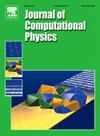An imbalanced learning-based sampling method for physics-informed neural networks
IF 3.8
2区 物理与天体物理
Q2 COMPUTER SCIENCE, INTERDISCIPLINARY APPLICATIONS
引用次数: 0
Abstract
This paper introduces Residual-based Smote (RSmote), an innovative local adaptive sampling technique tailored to improve the performance of Physics-Informed Neural Networks (PINNs) through imbalanced learning strategies. Traditional residual-based adaptive sampling methods, while effective in enhancing PINN accuracy, often struggle with efficiency and high memory consumption, particularly in high-dimensional problems. RSmote addresses these challenges by targeting regions with high residuals and employing oversampling techniques from imbalanced learning to refine the sampling process. Our approach is underpinned by a rigorous theoretical analysis that supports the effectiveness of RSmote in managing computational resources more efficiently. Through extensive evaluations, we benchmark RSmote against the state-of-the-art Residual-based Adaptive Distribution (RAD) method across a variety of dimensions and differential equations. The results demonstrate that RSmote not only achieves or exceeds the accuracy of RAD but also significantly reduces memory usage, making it particularly advantageous in high-dimensional scenarios. These contributions position RSmote as a robust and resource-efficient solution for solving complex partial differential equations, especially when computational constraints are a critical consideration.
基于不平衡学习的物理信息神经网络采样方法
本文介绍了基于残差的Smote (RSmote),这是一种创新的局部自适应采样技术,旨在通过不平衡学习策略提高物理信息神经网络(pinn)的性能。传统的基于残差的自适应采样方法虽然能有效地提高pin - n的精度,但往往存在效率和高内存消耗的问题,特别是在高维问题中。RSmote通过瞄准残差高的区域并采用来自不平衡学习的过采样技术来改进采样过程来解决这些挑战。我们的方法以严格的理论分析为基础,支持RSmote在更有效地管理计算资源方面的有效性。通过广泛的评估,我们将RSmote与最先进的基于残差的自适应分布(RAD)方法在各种维度和微分方程上进行了基准测试。结果表明,RSmote不仅达到或超过了RAD的精度,而且显著减少了内存使用,在高维场景中尤其具有优势。这些贡献使RSmote成为求解复杂偏微分方程的鲁棒且资源高效的解决方案,特别是当计算约束是一个关键考虑因素时。
本文章由计算机程序翻译,如有差异,请以英文原文为准。
求助全文
约1分钟内获得全文
求助全文
来源期刊

Journal of Computational Physics
物理-计算机:跨学科应用
CiteScore
7.60
自引率
14.60%
发文量
763
审稿时长
5.8 months
期刊介绍:
Journal of Computational Physics thoroughly treats the computational aspects of physical problems, presenting techniques for the numerical solution of mathematical equations arising in all areas of physics. The journal seeks to emphasize methods that cross disciplinary boundaries.
The Journal of Computational Physics also publishes short notes of 4 pages or less (including figures, tables, and references but excluding title pages). Letters to the Editor commenting on articles already published in this Journal will also be considered. Neither notes nor letters should have an abstract.
 求助内容:
求助内容: 应助结果提醒方式:
应助结果提醒方式:


